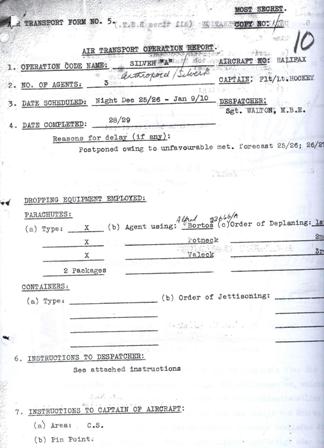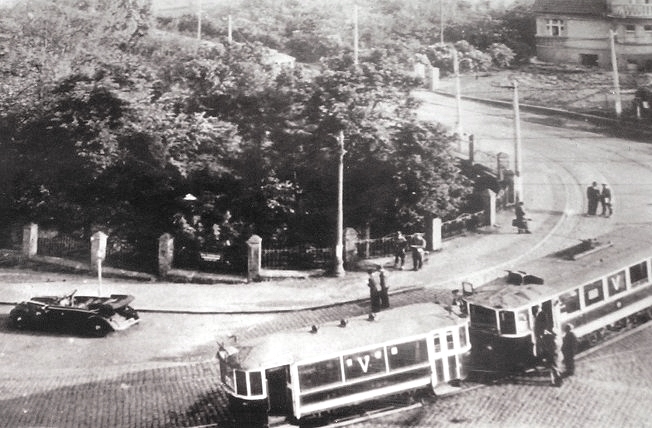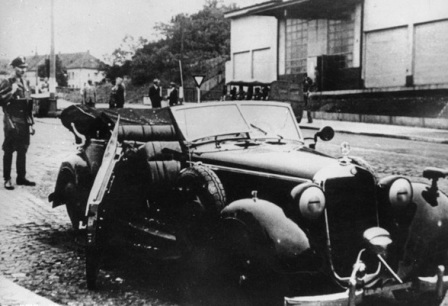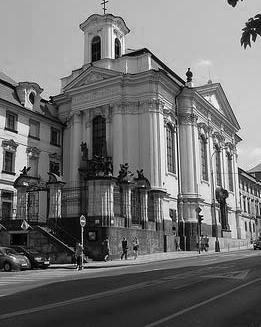Holocaust Education & Archive Research Team |
|
Occupation German Occupation of Europe Timeline
-
[The Occupied Nations]
Poland Austria Belgium Bulgaria Denmark France Germany Greece Hungary Italy Luxembourg The Netherlands Norway Romania Slovakia Soviet Union Sudetenland | |||||||||||
The Assassination of Reinhard Heydrich Operation Anthropoid
On the twenty-ninth of May, 1942, Radio Prague announced that Reinhard Heydrich, Reichsprotektor of Bohemia and Moravia, lay dying at the Bulovka hospital in Prague from wounds sustained in a daring ambush by Czech partisans as his car passed through the city outskirts at Holesovice, on the Rude Armady VII Kobylisky not far from the Vltava river.
The assassins attempted to kill Heydrich with automatic weapons but experienced a malfunction so a grenade was then tossed at the car by one of the Czechs. The resulting explosion caused sever damage to the right rear wing of the Mercedes, puncturing the tire and blowing a large hole in the bodywork.
The attackers then fled and, Heydrich attempted to shoot at the escaping assassins but his weapon also misfired. He then staggered back to the car and collapsed on the hood in severe pain.
He was rushed to the Bulovka emergency room shortly after 11:00 a.m. and was registered under the number 12.555/42. Heydrich's spleen had been fatally damaged and he contracted blood poisoning from grenade shrapnel, seat-spring splinters, and horse-hair used to cushion the cars upholstery.
He soon developed a fever and suffered from copious wound drainage until June 2, but the following day the fever appeared to have subsided. However, around noon, while Heydrich was sitting in bed eating a late breakfast, he suddenly went into shock and quickly lapsed into a deep coma from which he never recovered.
He died at 4:30 a.m. the next morning, June 4, 1942. The death of the Reichsprotektor of Bohemia and Moravia was recorded in the Bulovka death register as “Nr 348/1942.Reinhard Tristan Heydrich.
Cause of death: gunshot wound/murder attempt/wound infection.
So ended the life of Reinhard "The Hangman" Heydrich, the Butcher of Prague.
Operation Anthropoid
On September 27, 1941, the Czech Press Agency released the news that the Reich Protector Konstantin von Neurath had fallen ill, and Hitler had named a substitute Reich Protector, Reinhard Heydrich. The Protectorate at that time experienced numerous acts of sabotage and assassinations of Germans and their collaborators by the Czech underground.
The low morale and starvation level rations for workers had reduced Bohemia’s industrial output of armaments, putting essential part of the German war effort at risk.
Konstantin von Neurath was sent away to recuperate and on that very same day, a plane landed in Prague with Reinhard Heydrich on board. Heydrich, as SS Police General and chief of the Reichssicherheitschauptampt (RSHA, Reich Security Main Office) was one of the most powerful and most feared Nazi leaders in the party.
Considered exceptionally intelligent, hard-working, ambitious and totally amoral, he had climbed to the top of the SS hierarchy and ruthlessly crushed his and Hitler’s domestic and foreign enemies. He was the main architect of the “Final Solution,” Hitler’s plan to destroy European Jewry.
Hitler believed with Heydrich in charge of Bohemia and Moravia, the Czechs would soon learn what it meant to live under a master of suppression. Not being a man to disappoint the Fürher, Heydrich immediately put his plan into action with the objective of annihilating all resistance in the Czech Lands.
On September 28, 1941, at 11 am, the official inauguration began at Prague Castle, the next day Heydrich announced a martial law in Prague, Brno, Moravská Ostrava, Olomouc, Kladno and Hradec Králové.
He instituted what he called his "whip and sugar" policy; he increased the food rations to dissuade resistance among the Czechs, and he threatened to lower them if they did not work efficiently. This tactic seemed to resonate with the common workers but against the Czech intelligentsia, he would employ far deadlier measures.
Without hesitation he started from the top down. The Protectorate’s Prime Minister, General Alois Eliáš, was arrested, proven guilty of maintaining contacts with the enemy and sentenced to death on October 1, 1941.
Two acting leaders of the military resistance organization, Gen. Josef Bílý and Div. Gen. Hugo Vojta, Commander of the Bohemian Provincial Headquarters were sentenced under martial law and executed by a firing squad at Ruzyně Barracks. Hundreds from among the Czech intelligentsia were executed or sent to concentration camps.
From his quarters in Czernin Palace on October 2, 1941, Reinhard Heydrich gave a speech where he made the following statements:
"I must unambiguously and with unflinching hardness bring the citizens of this country, Czech or otherwise, to the understanding that there is no avoiding the fact they are members of the Reich and as such they owe allegiance to the Reich… This is a task of priority required by the war. I must have peace of mind that every Czech worker works at his maximum for the German war effort… This includes feeding the Czech worker – to put it frankly – so that he can do his work.”
One of Heydrich's first decrees, dated September 29, 1941,concerning the treatment of Jews and closing of synagogues stated:
“…Jewish synagogues and places of prayer have not been used for religious purposes for some time. Instead, they have become centers for all kinds of Jewish subversive elements and focal points of illegal whispered propaganda. For this reason I have ordered the closing of all Jewish synagogues and places of prayer.
This is to take effect immediately… Certain Czech circles are behaving in a very friendly manner toward the Jews, especially in recent times. They are mainly the Czech elements that are trying to demonstrate their anti-Reich thinking. I am ordering the State Police to intervene against the Czechs who openly demonstrate their friendship with the Jews in the streets and public places and place them in protective custody!.”
Concerning the Germanizing of Aryan types, and racial elements Heydrich had this to say:
“To be able to make a decision as to who is suited to be Germanized, I need their racial inventory…We have all kinds of people here, some of them are showing racial quality and good judgment. It’s going to be simple to work on them – we can Germanize them. On the other hand, we have racially inferior elements and, what’s worse, they demonstrate wrong judgment. These we must get out. There is a lot of space eastwards. Between these two extremes, there are those in the middle that we have to examine thoroughly.
We have racially inferior people but with good judgment, then we have racially unacceptable people with bad judgment. As to the first kind, we must resettle them in the Reich or somewhere else, but we have to make sure they no longer breed, because we don’t care to develop them in this area… One group remains, though, these people are racially acceptable but hostile in their thinking – that is the most dangerous group, because it is a racially pure class of leaders. We have to think through carefully what to do with them.
We can relocate some of them into the Reich, put them in a purely German environment, and then Germanize and re-educate them. If this cannot be done, we must put them against the wall.”
On June 18, 1941, Britain recognized the Czecho-Slovak government in exile in London, despite the fact that the Munich Agreement remained in force. Alarmed by Heydrich’s success, the Czechoslovak government in exile in London was in fear of slipping into last place among the representatives of the occupied countries that were actively contributing in their resistance to the defeat of Germany.
It was decided by former Czezh President Edvard Beneš and other political and military leaders in Paris and London that some action must be taken if they wanted to retain the leadership of the exiled movement under their control. That action was to be the assassination of Reinhard Heydrich.
The operation was to be named ANTHROPOID and full preparations for the attack began on October 2, 1941, in cooperation with the British SOE. Warrant Officer Josef Gabčík and Staff Sergeant Karel Svoboda were selected to carry out the assassination.
Josef Gabčík and Karel Svoboda left for a completion para-course in Manchester, where they were to carry out two daytime jumps from a Whitley aircraft and one night jump from a fixed balloon. It was a fateful leap from a fixed balloon for Staff Sergeant Svoboda. Who suffered a head injury during the jump and was replaced by Jan Kubiš at the request of Gabčík, but the date for the operation would now have to be postponed.
The postponement allowed the new team additional time to complete their training and to improve the plan and overall mission objective. Jan Kubiš and Josef Gabčík spent a week, in Scotland, where they graduated from the Special SOE Course under the tutelage of the Scottish Guard.
On October 20, 1941, both men were sent to Station XVII in Brickendonbury Manor, near London, which specialized in special operations training. There they learned specialized tactics in handling explosives. They also learned to create improvised explosive devices and sabotage techniques on railroad tracks, bridges and houses. They were trained in the use of electric and chemical fuses by British explosives expert Captain Pritchard of the SOE. It was Captain Pritchard who taught them how to handle the specially designed grenades and sensitive timers/fuses that would eventually be the downfall of Reinhard Heydrich.
After completing their training and receiving the necessary false documents required to move safely through the protectorate, Kubiš and Gabčík signed a pledge on Dec 1, 1941 in London.
“The substance of my mission basically is that I will be sent back to my homeland, with another member of the Czechoslovak Army, in order to commit an act of sabotage or terrorism at a place and in a situation depending on our findings at the given site and under the given circumstances.
I will do so effectively so as to generate the sought-after response not only in the home country but also abroad. I will do it to the extent of my best knowledge and conscience so that I can successfully fulfill this mission for which I have volunteered.”
On December 28, 1941, both Kubiš and Gabčík wrote their last will and testament, and at at 22:00 hours, Handley-Page Halifax Mk.II carrying 15 men took off from Tangmere Airport in Sussex in southern England.
The Halifax flew over the French coast to the Le Crotoy area, and from there headed towards Darmstadt, at around 00:42 hours they encountered German fighter planes but were able to avoid being shot down. Due to heavy snow cover the ANTHROPOID team missed their appointed drop zone and landed at near a village called Nehvizdy near Celakovice just east of Prague.
Upon dropping the parachutists the Halifax headed back towards Darmstadt where they encountered fire by by anti-aircraft batteries. Flying over the French coast at 07:20 hours and the touched down at Tangmere Airport at 08:19.
The ANTHROPOID team was equipped two pistols, a 38 COLT – with four full spare magazines and 100 bullets – six amour-piercing bombs filled with plastic explosives. two magazines of fuses, two model Mills grenades, one Tree Spigot bomb launcher with one bomb, four electric fuses, one Sten Mk.II machine gun with 100 bullets, 32 lbs. of plastic explosives, two yards of fuse rope, four smoke bombs, a reel of steel string and three timing pencils.
Gabčík and Kubiš then made their way to Pilsen to contact their allies, and from there on to Prague, where the attack was planned. In Prague, they contacted several families and anti-Nazi organizations who helped them during the preparations for the assassination. Gabčík and Kubiš initially planned to assassinate Heydrich on a train, but after exploration they realized that this was not possible.
The second plan was to assassinate him on the road in the forest on the way from Heydrich’s seat to Prague. They planned to pull a cable across the road that would stop Heydrich’s car but, after waiting several hours, their commander, Lt. Adolf Opálka, from the underground resistance group called "Out Distance", came to bring them back to Prague. The third plan was to assassinate Heydrich in Prague.
By April 1942 the team made a breakthrough when Heydrich moved from his temporary quarters in Prague Castle to a Château in Panenské Břežany. The drive from the chateau to the castle meant passing a sharp right 'hairpin" turn, straddling the streets Kirchmayerova and V Holešovičkách, below a school in Kobylisy.
The corner was considered the ideal location for the attack. As Heydrich's driver Johannes Klein took this route daily and had to slow down considerably to execute the turn. There was also a Tram stop located just near the corner which provided the assassins with a reason for waiting at the ambush location.
On the morning of May 27, 1942. Heydrich's black Mercedes driven by his adjutant SS-Oberscharführer Johannes Klein, approached the hairpin turn on Kirchmayer street on their daily commute from Panenské Břežany to Prague Castle.
Heydrich seeing Gabčík standing in front of him with the Sten orders Klein, to stop the car. He pulled his pistol and stood up to shoot at Gabčík from the car, not noticing Kubiš who tossed the grenade at the Mercedes.
The bomb goes off and and its fragments ripped through the car’s right fender, embedding shrapnel and fibers from the upholstery into Heydrich’s body, even though the grenade failed to enter the car. Kubiš is also injured by the shrapnel.
Heydrich, apparently unaware of his shrapnel injuries, got out of the car, returned fire, and tried to chase Gabčík but soon collapsed. Klein returned from his abortive attempt to chase Kubiš, and Heydrich ordered him to chase Gabčík. Klein was shot twice by Gabčík now using a revolver. During their escape, neither Gabčík or Kubiš is aware of the wounds sustained by Heydrich in the bomb blast and both were convinced that the attack was a failure.
Heydrich was taken to Bulovka Hospital, near the site of the attack. There he was operated on by Professor Hollbaum, a Silesian German who was Chairman of Surgery at Charles University in Prague, assisted by Doctor Dick, the Sudeten German Chief of Surgery at the hospital.
At 3:26 pm on May 27, 1942 SS-Standartenführer Horst Böhme reported the results of Heydrich’s first operation to Berlin:
“…a lacerated wound to the left of the back vertebrae without damage to the spinal cord. The projectile, a piece of sheet metal, shattered the 11th rib, punctured the stomach lining, and finally lodged in the spleen.
The wound contains a number of horsehair and hair, probably material originating from the upholstery. The dangers: festering of the pleura due to pleurisy. During the operation the spleen was removed."
On May 27, 1942, Karl. Hermann Frank, declared a state of civil emergency. Posters appeared in the streets offering a reward for information on the perpetrators. Himmler, at Hitler’s headquarters in Rastenburg was immediately notified of the incident and ordered Dr. K. Gebhardt, his personal physician and Professor of Orthopedics in Berlin, to fly at once to Heydrich’s bedside.
Gebhardt landed in Prague the evening of May 27, and followed Heydrich progress closely even telephoning Himmler twice a day to report on his patient’s status.
Hitler ordered the SS and Gestapo to “wade in blood” throughout Bohemia to find Heydrich’s killers. Hitler wanted to start with brutal, widespread killing of the Czech people but, after consultations, he reduced his response to only some thousands. The Czech lands were an important industrial zone for the German military and indiscriminate killing could reduce the productivity of the region.
Things went from bad to worse for the ANTHRPOID team and their collaborators in hiding. Karel Čurda another of the men from the OUT DISTANCE unit, who left Prague immediately after the assassination and hid out with his mother in Nová Hlína near Třeboň, was captured by the Gestapo and betrayed the names of the team’s local contact persons for the bounty of 1 million Reichsmarks.
First, on June 13, 1942, he wrote a traitorous letter in which he identified Gabčík and Kubiš as the assassins. Čurda then betrayed to the Gestapo everyone he knew personally who had assisted the paratroopers, not only in Prague but in Pardubice, Lázně Bělohrad and Pilsen. Through his betrayal he caused the deaths of Czech patriots and their families.
The very next morning, the Gestapo began extended raids on the apartments of the people who had assisted the paratroopers. The first in line was the Moravec family in Biskupcova Street in Prague. The Moravec family was made to stand in the corridor while the Gestapo searched their apartment.
Mrs. Moravec was allowed to go to the toilet, and killed herself with a cyanide capsule. Mr. Moravec, oblivious to his family's involvement with the resistance, was taken to the Peček Palác together with his son Ata. Ata was tortured throughout the day. Finally, he was stupefied with brandy and shown his mother's severed head in a fish tank . Ata Moravec told the Gestapo all he knew.
At 3:45 am on June 18, 1942, SS-Brigadeführer Karl von Treuenfeld, issued an order to the Reserve Battalion Deutschland and the Guard Battalion Prague to surround the area around the Church of St. Cyril and Methodius. The location of where Kubiš, Gabčík and Opálka were hiding.
German Police under the command of Gestapo Chief Heinz Pannwitz and Nazi Secretary of State Karl Frank quickly overpowered the priest, Father Vladimir Petrek and von Treuenfeld was given the order to attack. The battled ensued for fourteen hours as the Czech parachutists put up fierce resistance.
The Germans first searched the church warden’s apartment. They quickly found the window with an unscrewed inside grating, which would have been used in the event of the paratroopers’ escape. The Gestapo and SS then proceeded to the inner section of the Church of St. Cyril and Methodius, where Adolf Opálka, Josef Bublík and Jan Kubiš were keeping guard in the gallery and the choir.
The attackers tried to reach the choir through a narrow staircase, under cover fire provided by Adolf Opálka. Wounded and nearing the end of his ammunition Adolf Opálka took poison and simultaneously ended his life with a pistol shot to the left temple. After the inside of the church was overrun, the battle shifted to the crypt, the only entrance to which led through a small ventilation opening in the western part of the church which was accessible from the street outside. The Germans seized this opportunity and ordered in the Prague fire department to begin flooding the crypt with water and tear gas.
Near the altar, under a carpet, the Germans found an entrance into the crypt covered with a stone slab. After destroying it with explosives, they discovered steep stairs leading into the crypt; the Czechs were now fighting from all sides. Pannwitz and Frank had Čurda brought in to try and persuade the men in the crypt to surrender, but his shouts for them to give themselves up were met by fire form the defenders guns. The Czech's thought they might have a chance if they could tunnel there way out of the crypt into the sewer system below, but Jan Kubiš suffered from multiple gun shot and grenade wounds and died of blood loss.
The remaining defenders both exhausted and their ammunition just about gone, chose suicide over capture. Josef Gabčík ended his own life with a pistol shot. Fourteen German soldiers had been killed and many more injured in the series of attacks. The dead paratroopers were carried out in front of the church and identified by the traitor Karel Čurda.
The assassination led to the reprisal of the complete destruction of the village of Lidice, 173 Lidice men were shot on that fateful day in the garden of the Horak farm. Read more about the Lidice massacre [here].
Jan Kubiš' girlfriend, Anna Malinova, was arrested in the aftermath of the assassination, and died in Mauthausen concentration camp. Many Resistance helpers were also arrested and murdered, including Father Petrek.
The Germans erected a monument to Heydrich which was torn down by the Czechs in 1945. Hitler granted Lina, Heydrich's widow, heavily pregnant at the time of his death, the estate at Panenske Brezany, and she ended her days as a hotel-keeper on the island of Fehmarn. Hitler eulogized Reinhard Heydrich in ceremony in Berlin on June 9, 1942: "I have only a few words to dedicate to this dead man. He was one of the best National Socialists, one of the strongest defenders of German Reich, one of the biggest opponents of all the enemies of the Reich. He fell as a martyr for the preservation and safeguarding of the Reich. As leader of the party and as leader of the German Reich, I give you, my dear comrade Heydrich, the highest recognition I have to bestow, the uppermost level of the German Order. " A memorial pamphlet entitled "My Honor is Loyalty" was Issued by: the Reich Security Main Office I B I shortly after Heydrich's death. You can read more about Reinhard Heydrich [here].
Sources:
Die Sudetendeutschen im NS-Staat. Politik und Stimmung der Bevölkerung im Reichsgau Sudetenland (1938-1945).Zimmermann, Volker Master of Spies. The Memoirs of General Frantisek Moravec (London 1975) Heydrich: The Face of Evil, by Mario R. Dederichs, tr. Geoffrey Brooks (Greenhill Books, London 2006) "Reinhard Heydrich — Der deutsche Polizeichef als Jagdflieger", by Stefan Semerdjiev, Deutsche Militärzeitschrift, No 41 Sept/Okt.2004 Assassination : Operation Anthropoid 1941-1942, by Michael Burian (Avis, Prague 2002) SS Service Record of Reinhard Heydrich, National Archives and Records Administration, College Park Central Intelligence Agency Report on the Assassination of Reinhard Heydrich The Mirror Caught The Sun - Operation Anthropoid 1942 by John Martin
Copyright Carmelo Lisciotto H.E.A.R.T 2009
|



